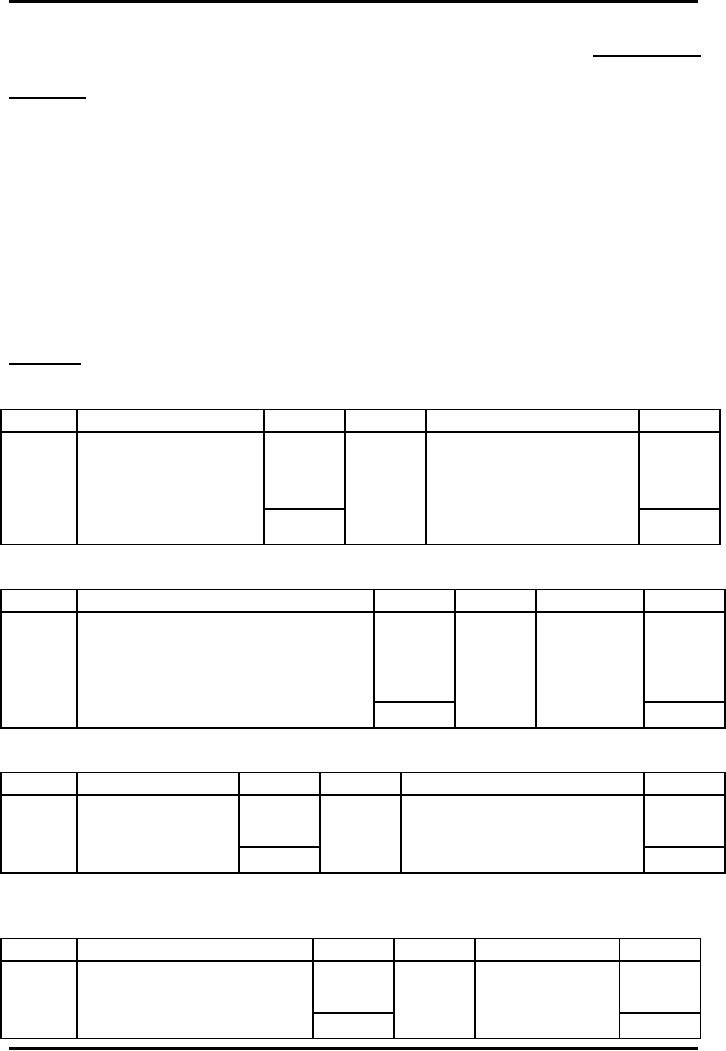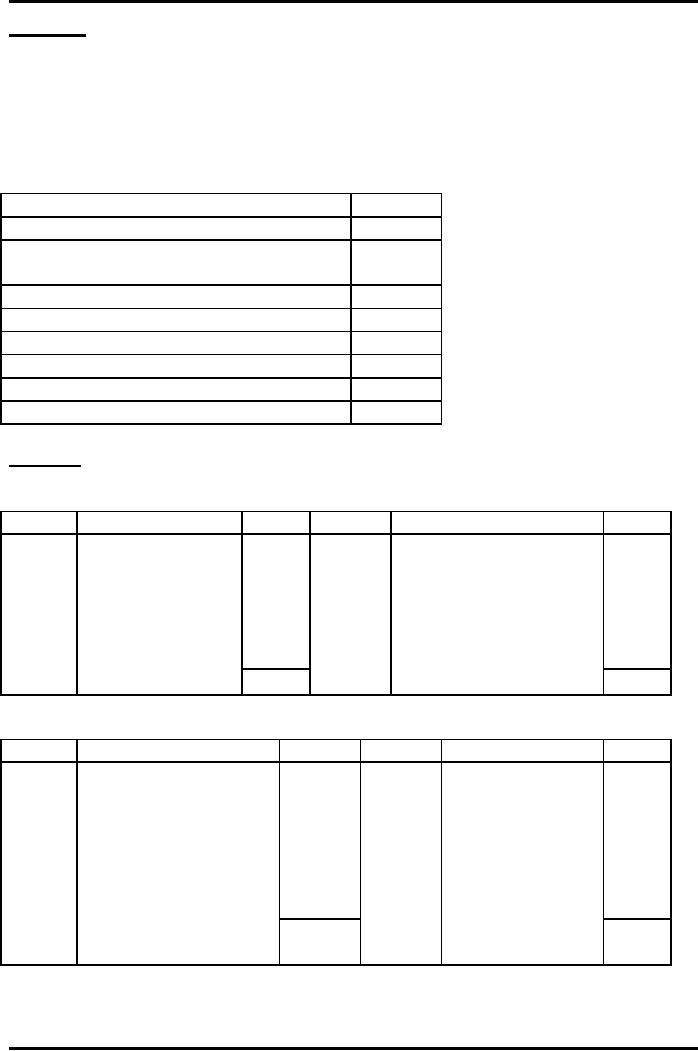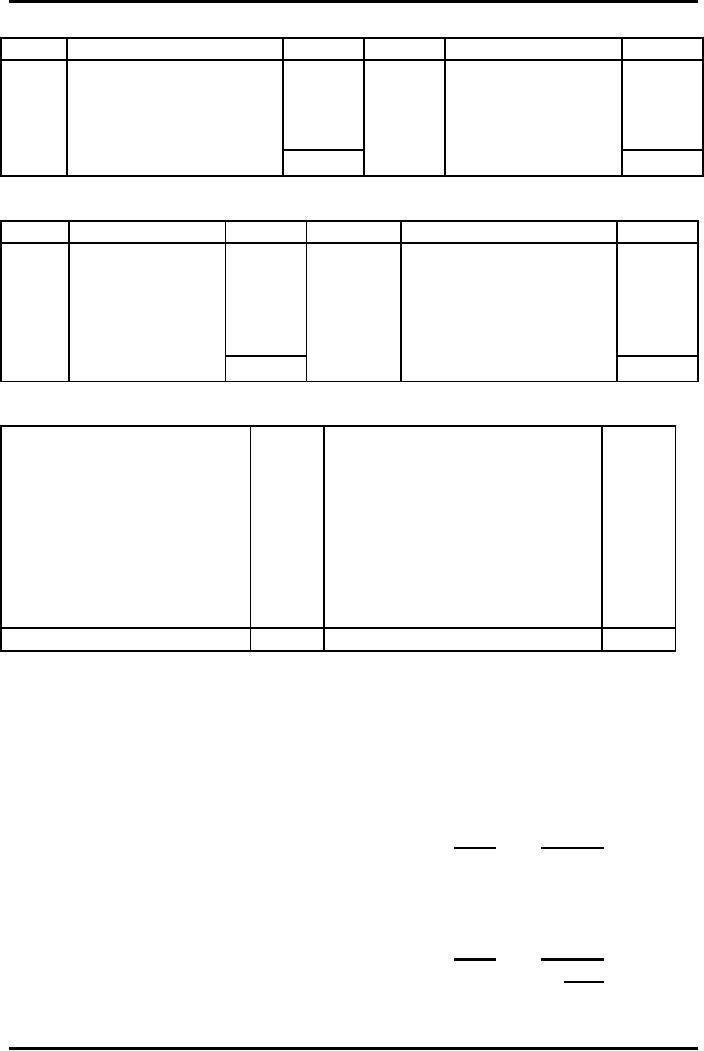 |
STOCK AND DEBTORS SYSTEM |
| << BRANCH ACCOUNTING - STOCK AND DEBTOR SYSTEM |
| INDEPENDENT BRANCH >> |

Advance
Financial Accounting
(FIN-611)
VU
LESSON
# 14
STOCK
AND DEBTORS
SYSTEM
Question
On 1st January, 2008 goods costing
Rs. 132,000 were invoiced by Multan
head office to
its
new branch at Lahore and charged at
selling price to produce a
gross profit of 25%
on
the selling price. At the
end of the year, the return
from Lahore Branch showed
that
the
credit sales were Rs.
150,000. Goods invoiced at
Rs. 2,000 to Lahore branch
have
been
returned to Multan head office.
The closing stock at Lahore
branch was Rs.
24,000
at
selling price. Record the
above transactions in the
books of
(i)
Lahore Branch Stock Account;
(ii) Goods Sent to Lahore
Branch Account; (iii)
Lahore
Branch Adjustment Account; and (iv)
Lahore Branch Debtors
Account in the
head
office book and close the
said accounts on 31st December 2008.
Solution
In
the Books of the Head
Office, Multan
Dr.
Lahore
Branch Stock
Account
Date
Particulars
Rs.
Date
Particulars
Rs.
2008
To
Goods Sent to
176,000
2008
By
Goods Sent to LHR
2,000
Dec.1
LHR
Br. A/c
Dec.31
Br.
A/c (Returns)
150,000
By
Branch Debtor A/c
24,000
(Credit
Sales)
176,000
176,000
By
Balance c/d
Dr.
Goods
Sent to Lahore Branch
Account
Date
Particulars
Rs.
Date
Particulars
Rs.
2008
To
Lahore Branch Stock
A/c
2,000
2008
By
Lahore
176,000
Dec.31
(Returns)
Dec.31
Branch
43,500
To
Lahore Branch Adjustment
A/c
Stock
A/c
To
Purchases A/c (Transferred)
130,500
176,000
176,000
Dr.
Lahore
Branch Debtors
Account
Date
Particulars
Rs.
Date
Particulars
Rs.
2008
To
Lahore Brach
150,000
2008
By
Balance c/d
150,000
Dec.31
Stock
A/c
Dec.31
150,000
150,000
Dr.
Lahore
Branch Adjustment
Account
Cr.
Date
Particulars
Rs.
Date
Particulars
Rs.
2008
To
Stock Reserve A/c
6,000
2008
By
Goods Sent
43,500
Dec.31
To
General Profit &
Loss
37,500
Dec.31
to
Delhi Branch
A/c
A/c
43,500
43,500
64

Advance
Financial Accounting
(FIN-611)
VU
Question
X Ltd. of
Karachi has a branch at
Lahore. Goods are invoiced
to the branches at
cost
plus
331/3%. The
branch remits all cash
received to the head office
and all expenses are
paid
by the head office. From
the following particulars, prepare
Branch Stock Account,
Branch
Adjustment Account, Branch
Debtors Account and Branch
Profit & Loss
Account
in the books of the head
office. (All figures in
Rs.)
Branch
Debtors on 1.1.2008
6,000
Branch
Stock on 1.1.2008 (invoice
price)
2,400
Sales
Cash
3,000
Credit
60,000
Goods
from head office (invoice
price)
72,000
Cash
received from Debtors
57,600
Discount
allowed to Debtors
1,400
Bad
debts
300
Branch
expenses paid by Head
Office
5,000
Branch
stock on 31.12.2008 (invoice
price)
12,000
Solution
In
the Books of the Head
Office, Karachi
Dr.
Branch
Stock Account
Date
Particulars
Rs.
Date
Particulars
Rs.
2008
To
Balance b/d
2,400
2008
Jan.1
To
Goods Sent to
Dec.31
By
Bank A/c (Cash
3,000
Dec.31
Branch
A/c
sales)
72,000
60,000
Branch
By
Branch Debtors A/c
12,000
Adjustment
By
Balance c/d
(Surplus)
600
75,000
75,000
Dr.
Branch
Adjustment Account
Date
Particulars
Rs.
Date
Particulars
Rs.
2008
To
Stock Reserve A/c
3,000
2008
By
Stock Reserve
600
Dec.31
(12,000
x �)
Dec.31
A/c
(2,400 x
To
Gross c/d
33.33/133.33)
16,200
(Transferred
to Branch
By
Goods sent to
18,000
PLS
A/c)
Branch
A/c
Branch
Stock
(Surplus)
600
19,200
19,200
65

Advance
Financial Accounting
(FIN-611)
VU
Dr.
Branch
Profit & Loss
Accountr.
Date
Particulars
Rs.
Date
Particulars
Rs.
2008
To
Branch Expenses A/c
2008
By
Gross Profit b/d
16,200
Dec.3
Discount
Allowed
1,400
Dec.31
By
General Profit &
500
300
1
Bad
debts
Loss
A/c (Loss)
15,000
Cash
Expenses
16,700
16,700
Dr.
Branch
Debtors Account
Date
Particulars
Rs.
Date
Particulars
Rs.
Jan.1
To
Balance b/d
6,000
2008
By
Bank A/c
57,600
2008
Dec.31
By
Branch Expenses A/c
1,400
Discount
Allowed
Bad
debts
300
To
B
Dec31
60,000
By
Balance c/d
6,700
ranch
Stock A/c
66,000
66,000
Branch
Account
Rupees
Rupees
6,000
Cash Received
60,600
Opening
Debtors
1,800
Goods Returned
0
Opening
Stock (at cost)
72,000
Goods sent to branch
(loading)
18,000
Goods
sent to branch (at
15,000
Closing Debtors
6,700
Inv.)
9,000
Cash
sent to branch
Closing
Stock (at cost)
500
Income
Statement (loss)
94,800
94,800
Branch
Income
Statement
Rupees
Sales
63,000
Cost
of goods sold
Opening
stock (at cost)
1,800
Goods
received from head office
(at cost)
54,000
(46,800)
Closing
stock (at cost)
9,000
Gross
profit
16,200
Operating
expenses
Cash
expenses
15,000
Bad
debts
300
Discount
allowed
1,400
(16,700)
Loss
transferred to head office
Income Statement
(500)
Whole
Sale Branch
66

Advance
Financial Accounting
(FIN-611)
VU
Sometimes,
the head office
(specifically dealing the
manufacturing activities)
sells
goods
to actual consumers through its
retail shops. In this case,
the head office
sends
goods
to the branches at wholesale
prices which cost plus a percentage of
profit. The
branch
is likely to sell those
goods at retail prices which is
more than the
wholesale
prices.
The real profit earned by
the branch is the difference
between the retail
selling
price
and the wholesale price. For
example the cost price of an
article is Rs. 100,
the
wholesale
price, Rs. 160 and the
retail selling price, Rs.
180. Where an article is
sold by
the
branch, the actual profit is
Rs. 180 100 = Rs. 80 but the
branch's profit is Rs. 180
160 =
Rs. 20.
This
system of accounting is followed for
dependent branches where
these are treated
as
profit centre only. The real
cost of the branch is the
whole sale price of the
goods
sent.
But, we must remember that
wholesale prices are fixed
above cost. Therefore,
if
all
the goods that have
been sent to branch are
sold no problem arises. The
real
problem
arises when a part of stock
remains unsold at the
branch, which includes an
element
of profit that could not be
realized by the head office.
Such unrealized profit
is
reversed
in the books of head office
by recording this accounting
entry:
Income
Statement a/c
Dr.
(Wholesale
price less cost
price)
Stock
Reserve a/c Cr.
In
the balance sheet the
branch stock is shown at cost
i.e. after deducting
stock
reserves.
67
Table of Contents:
- ACCOUNTING FOR INCOMPLETE RECORDS
- PRACTICING ACCOUNTING FOR INCOMPLETE RECORDS
- CONVERSION OF SINGLE ENTRY IN DOUBLE ENTRY ACCOUNTING SYSTEM
- SINGLE ENTRY CALCULATION OF MISSING INFORMATION
- SINGLE ENTRY CALCULATION OF MARKUP AND MARGIN
- ACCOUNTING SYSTEM IN NON-PROFIT ORGANIZATIONS
- NON-PROFIT ORGANIZATIONS
- PREPARATION OF FINANCIAL STATEMENTS OF NON-PROFIT ORGANIZATIONS FROM INCOMPLETE RECORDS
- DEPARTMENTAL ACCOUNTS 1
- DEPARTMENTAL ACCOUNTS 2
- BRANCH ACCOUNTING SYSTEMS
- BRANCH ACCOUNTING
- BRANCH ACCOUNTING - STOCK AND DEBTOR SYSTEM
- STOCK AND DEBTORS SYSTEM
- INDEPENDENT BRANCH
- BRANCH ACCOUNTING 1
- BRANCH ACCOUNTING 2
- ESSENTIALS OF PARTNERSHIP
- Partnership Accounts Changes in partnership firm
- COMPANY ACCOUNTS 1
- COMPANY ACCOUNTS 2
- Problems Solving
- COMPANY ACCOUNTS
- RETURNS ON FINANCIAL SOURCES
- IASB’S FRAMEWORK
- ELEMENTS OF FINANCIAL STATEMENTS
- EVENTS AFTER THE BALANCE SHEET DATE
- PROVISIONS, CONTINGENT LIABILITIES AND CONTINGENT ASSETS
- ACCOUNTING POLICIES, CHANGES IN ACCOUNTING ESTIMATES AND ERRORS 1
- ACCOUNTING POLICIES, CHANGES IN ACCOUNTING ESTIMATES AND ERRORS 2
- BORROWING COST
- EXCESS OF THE CARRYING AMOUNT OF THE QUALIFYING ASSET OVER RECOVERABLE AMOUNT
- EARNINGS PER SHARE
- Earnings per Share
- DILUTED EARNINGS PER SHARE
- GROUP ACCOUNTS
- Pre-acquisition Reserves
- GROUP ACCOUNTS: Minority Interest
- GROUP ACCOUNTS: Inter Company Trading (P to S)
- GROUP ACCOUNTS: Fair Value Adjustments
- GROUP ACCOUNTS: Pre-acquistion Profits, Dividends
- GROUP ACCOUNTS: Profit & Loss
- GROUP ACCOUNTS: Minority Interest, Inter Co.
- GROUP ACCOUNTS: Inter Co. Trading (when there is unrealized profit)
- Comprehensive Workings in Group Accounts Consolidated Balance Sheet